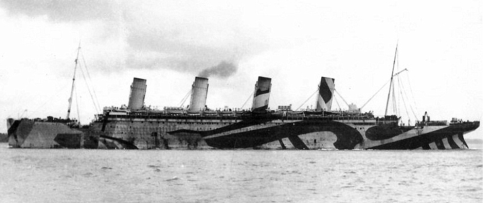It transpires that Leonard Campbell Taylor – younger brother of Fluff Taylor and the artist responsible for the front cover of our magazine, the ‘Draconian‘ – has been involved in most interesting work as a War Artist. He was attached to the port of Liverpool to supervise our ships with dazzle camouflage.
He is now able to reveal some of his work for us.
 “The whole aim and object of this scheme is not invisibility, but so to distort the appearance of a vessel at sea and all its parts, especially the bridge, funnels and bows, that a Hun U-boat commander in making his reckoning of the ship’s course becomes confused and wrong in his calculation…”
“The whole aim and object of this scheme is not invisibility, but so to distort the appearance of a vessel at sea and all its parts, especially the bridge, funnels and bows, that a Hun U-boat commander in making his reckoning of the ship’s course becomes confused and wrong in his calculation…”
It is interesting to hear that a apparently only one sixth of daylight penetrates a periscope, which must make it even more difficult, and often U-boats actually surface to identify their targets. The effectiveness of this camouflage is demonstrated in Leonard’s account of one of our biggest ships, HMT Olympic, encountering a U-boat:
“The German Commander having made his calculations, correct as he no doubt thought, dived and again rose to the surface to find his quarry not at all where he expected her to be, instead he found himself right under the towering bows of the monster ship, who went full speed ahead, rammed the U-boat, split her in two, and when the Hun Commander was rescued from the water and taken prisoner, he owned that it was entirely due to the dazzle plan of the Olympic that he was so disastrously out in his reckoning.”
The person credited as the inventor of dazzle painting is Lieut.-Commander Norman Wilkinson (RNVR), who had been a marine artist before the War.
“There were about 420 designs in all, so many being applicable to each of the (roughly) 30 different types of merchantmen in existence, but special plans were designed for the large liners such as the Olympic, Mauretania, Aquitania, and Leviathan and for HM Cruisers, Sloops and Gunboats, each having its own design and sharing it with no other vessel.
Nearly all ships over 100 feet in length were eventually dazzled and on arrival in port, no matter how short a time previously painted, each vessel had to be touched up or entirely repainted with a new plan if the inspecting dazzle officer considered it necessary.
Acres had to be covered, sometimes in a very short space of time, for ships were not allowed to be detained a moment beyond their sailing time, and a couple of hundred or more men would be put to work on a large liner, and then you would scarcely notice them when distributed over over one of these immense vessels…
Dazzle Officers were stationed at all the important ports of Great Britain and Ireland and at those of Gibraltar, Malta and Port Said. Their business was to train the foreman, to supervise the work while in progress and to inspect finally each ship…
One’s life was consequently spent in the docks and among the ships, when not engaged in office work, and a marvellous place these docks at Liverpool are, with their river frontage of 8½ miles and the Birkenhead docks just across the Mersey. Here there was work night and day – a thousand repairs and alterations to be made, cargo vessels to be converted into troopships, guns and their platforms to be erected on board, Marconi houses, horse boxes, railway wagons and even large river steamers and launches to be placed on deck, cargo to be loaded or discharged and ships in dry dock, with gaping holes in their sides or bows twisted like a piece of tin-foil, having suffered from mine, torpedo or collision, to be patched up and mended…
There are about 30 miles of sheds in the Liverpool docks, varying from 60 to 90 feet wide, and there you can see almost everything, animal, vegetable and mineral, that the world produces.”



Hi Desmond, what an interesting piece. I wonder if any objective work was done on how effective the dazzle designs really were?
All the best,
David
From Lord Poole.
New Address: 2, Locks Farm Cottages, Botley Road, Bishops Waltham, SO32 1DR
Tel: 01489 893519, 07949 330428
LikeLike
Intriguing to read that such artistry actually worked!
LikeLike